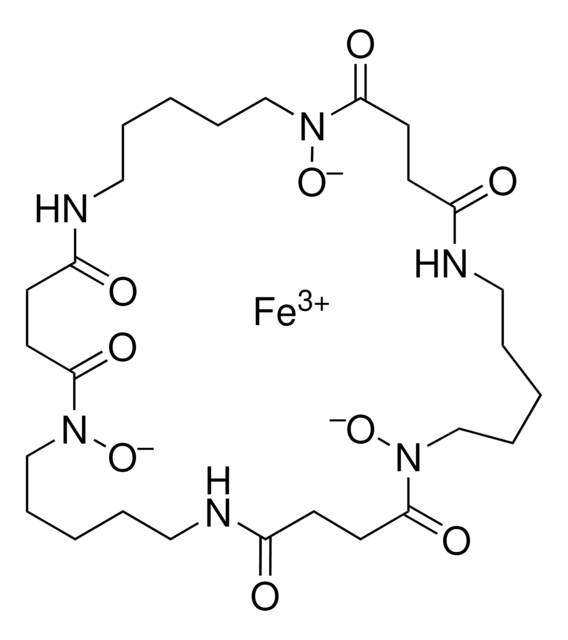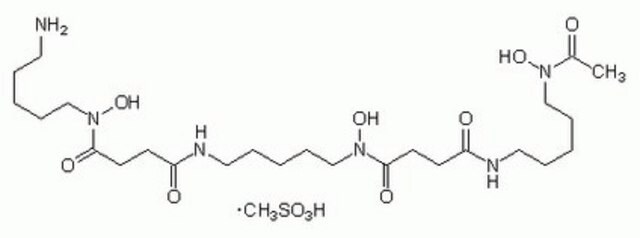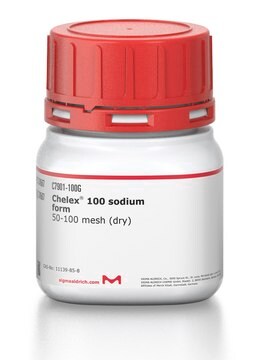P8374
Pyoverdines−Fe complex
from Pseudomonas fluorescens, >90% (HPLC)
Synonym(s):
Pyoverdines, Fe-Pv
Sign Into View Organizational & Contract Pricing
All Photos(1)
About This Item
UNSPSC Code:
12352200
NACRES:
NA.32
Recommended Products
biological source
Pseudomonas fluorescens
Quality Level
Assay
>90% (HPLC)
form
powder
solubility
H2O: ~10 mg/mL
shipped in
wet ice
storage temp.
−20°C
Looking for similar products? Visit Product Comparison Guide
Application
Pyoverdines-Fe complex has been used in cyclic voltammetry to determine potential detection windows and peak potentials.
Biochem/physiol Actions
Pyoverdines, also called pseuobactins and pyoverdins, are fluorescent siderophores that have high affinity for iron (1032 M-1), and are synthesized by fluorescent pseudomonads under iron-deficient growth conditions. Pyoverdines were shown to prevent iron toxicity produced by iron overload in hepatocyte cultures and effectively scavenges the hydroxyl and peroxyl radicals. Pyoverdines are effective in acquiring iron from transferrin and lactoferrin. Pyoverdines are also involved in the suppression of pythium-induced damping-off of tomato and promotion of growth in some higher plants.
The complex ferri-pyoverdine acts as a signaling molecule inducing the production of secreted virulence factors in Pseudomonas aeruginosa. Ferri-pyoverdines promote the growth of both P. fluorescens and P. aeruginosa in minimal medium.
Physical form
Supplied as a mixture containing mainly the succinic acid (MW=1161), 2-hydroxy glutaramide (MW=1190), and succinamide (MW=1160) forms of pyoverdines, bound to iron.
related product
Product No.
Description
Pricing
Storage Class Code
11 - Combustible Solids
WGK
WGK 3
Flash Point(F)
Not applicable
Flash Point(C)
Not applicable
Choose from one of the most recent versions:
Already Own This Product?
Find documentation for the products that you have recently purchased in the Document Library.
Paul A Beare et al.
Molecular microbiology, 47(1), 195-207 (2002-12-21)
Under iron-limiting conditions, Pseudomonas aeruginosa produces a siderophore called pyoverdine. Pyoverdine is secreted into the extracellular environment where it chelates iron, and the resulting ferri-pyoverdine complexes are transported back into the bacteria by a cell surface receptor protein FpvA. Pyoverdine
Electrochemical sensing of biomarker for diagnostics of bacteria-specific infections
Fatima A
Nanomedicine (London, England) (2016)
Fast Selective Detection of Pyocyanin Using Cyclic Voltammetry
Sensors (2016)
Islem Gandouzi et al.
Materials (Basel, Switzerland), 12(7) (2019-04-14)
Pyoverdine is a fluorescent siderophore produced by Pseudomonas aeruginosa that can be considered as a detectable marker in nosocomial infections. The presence of pyoverdine in water can be directly linked to the presence of the P. aeruginosa, thus being a
Our team of scientists has experience in all areas of research including Life Science, Material Science, Chemical Synthesis, Chromatography, Analytical and many others.
Contact Technical Service







